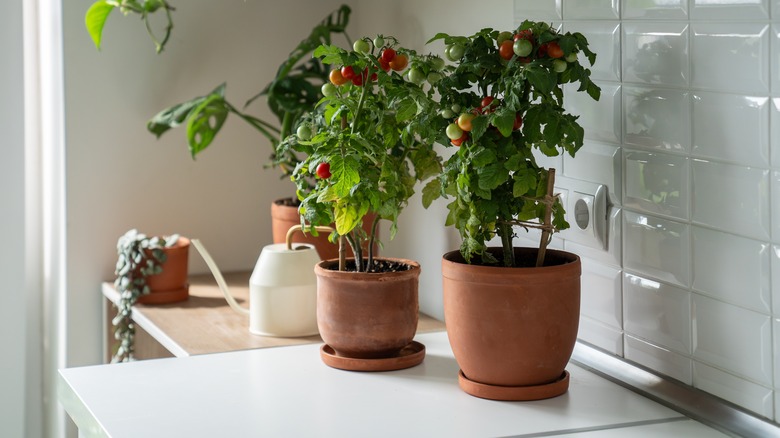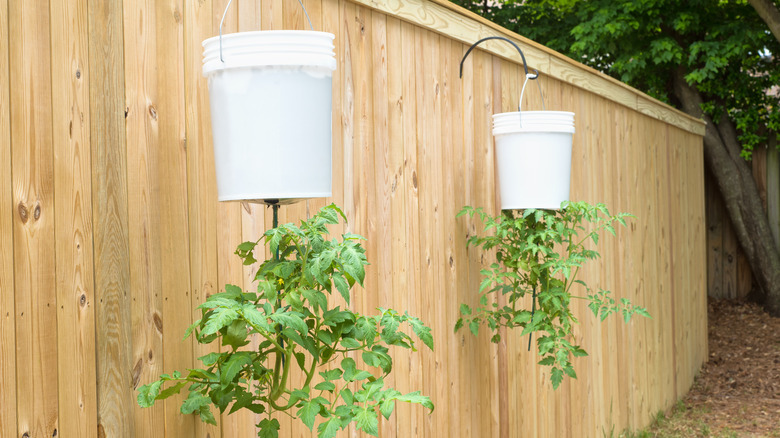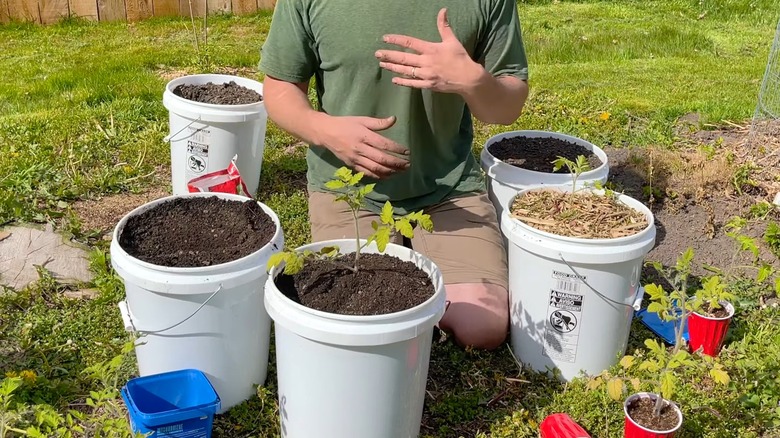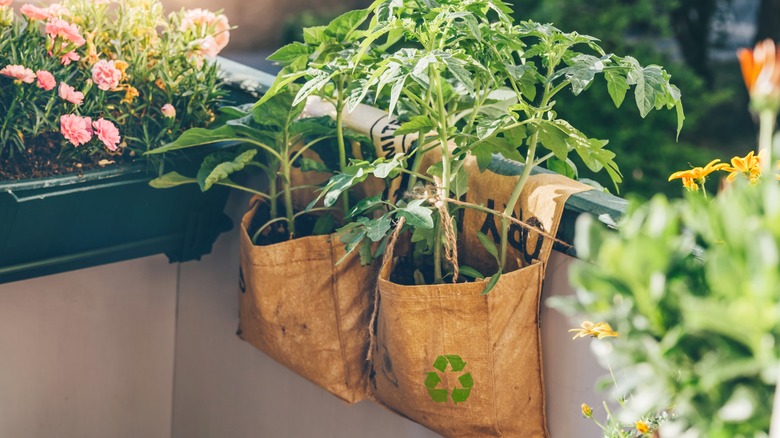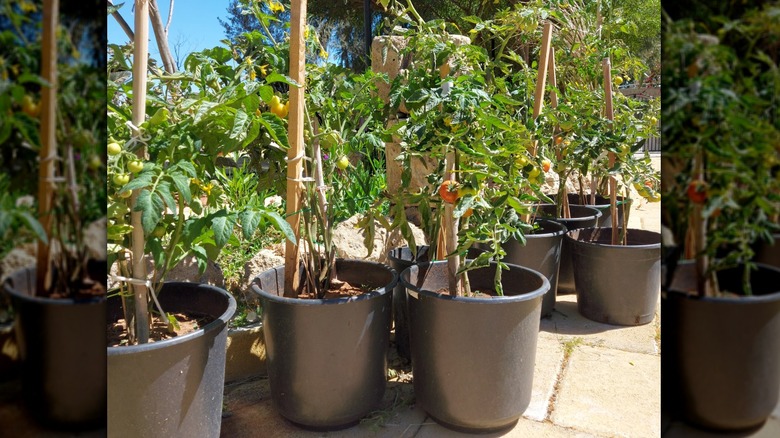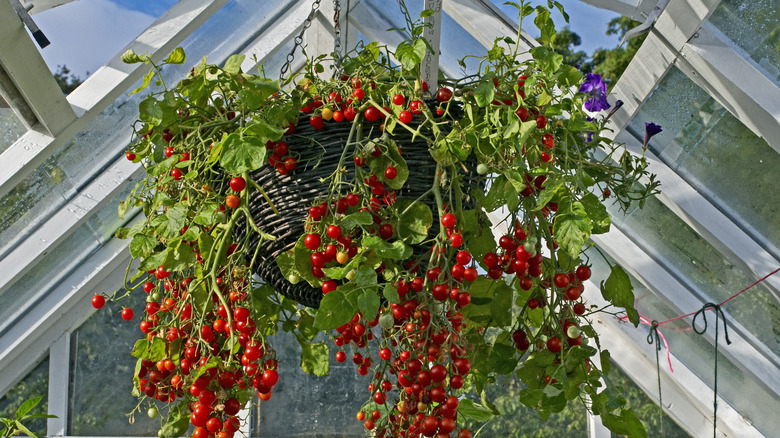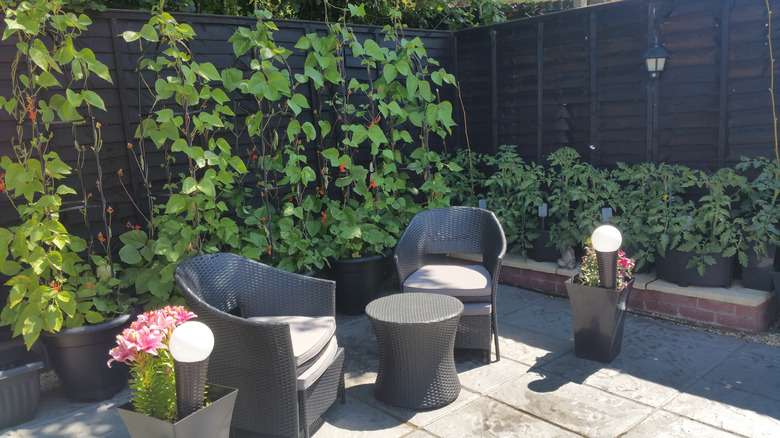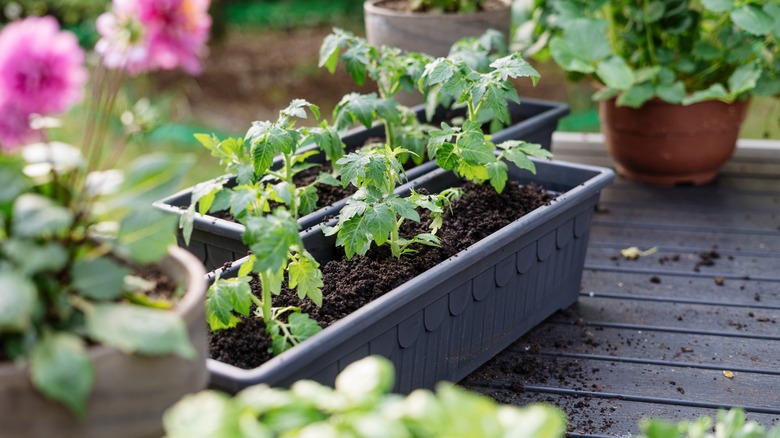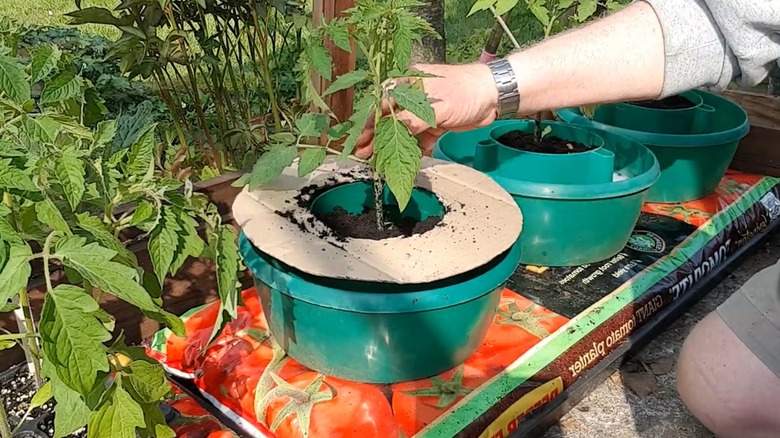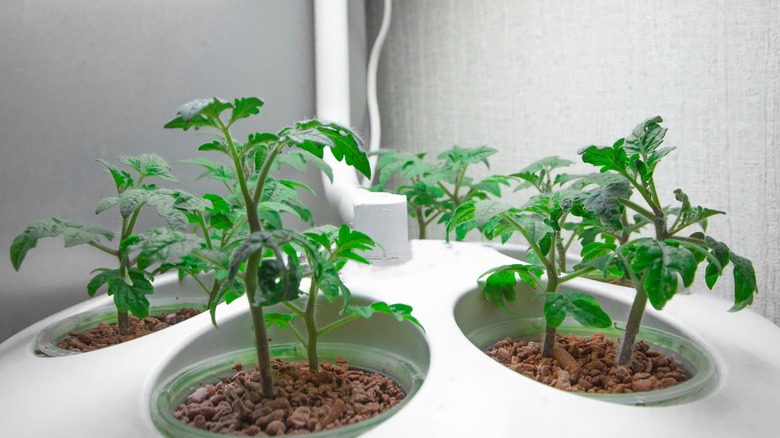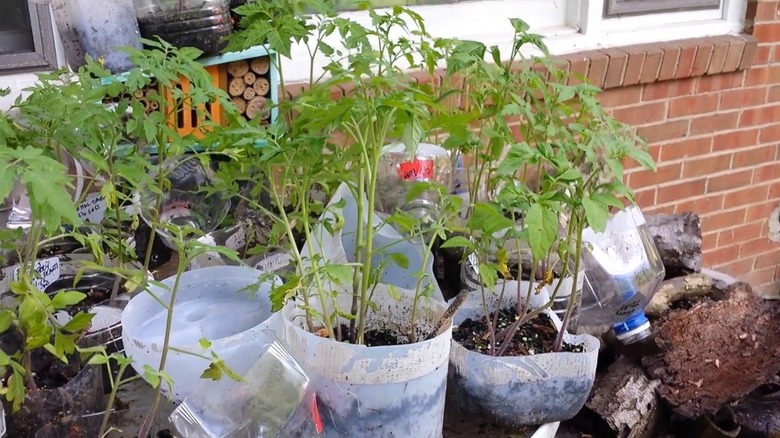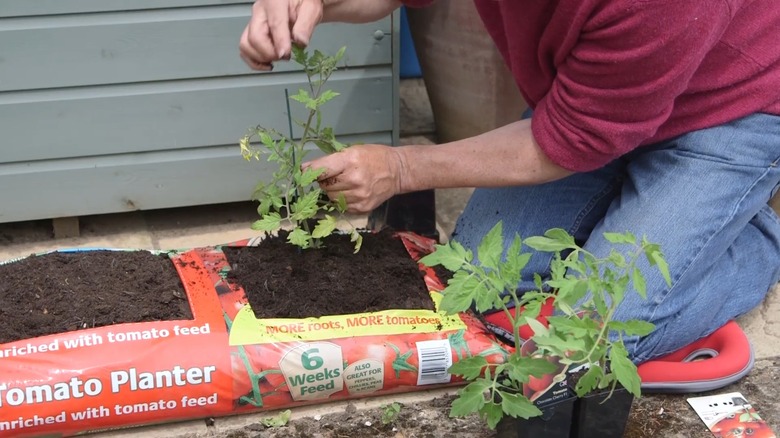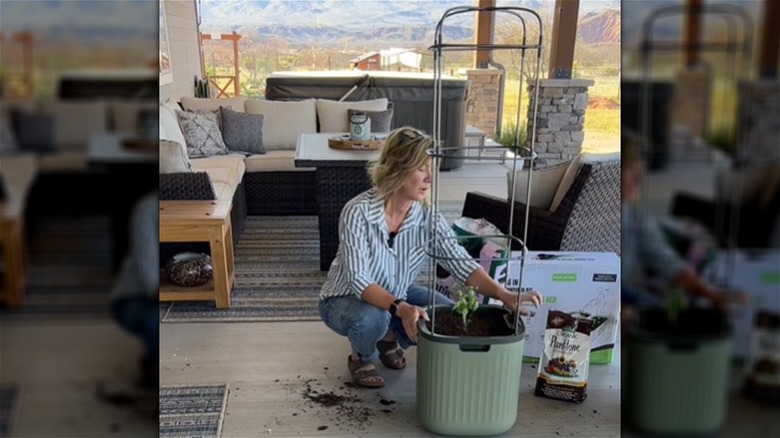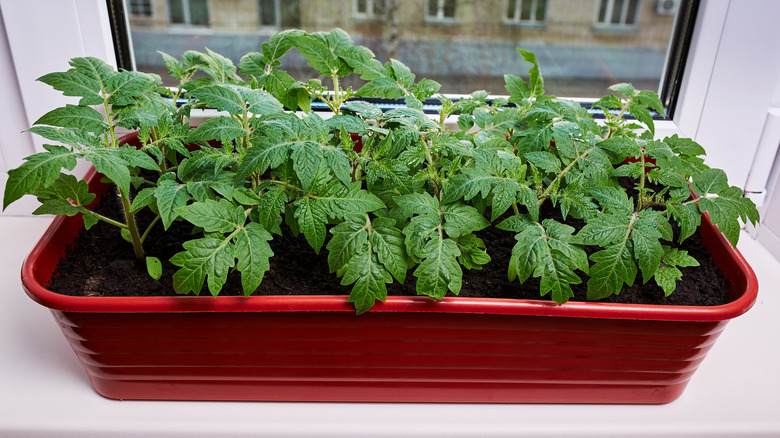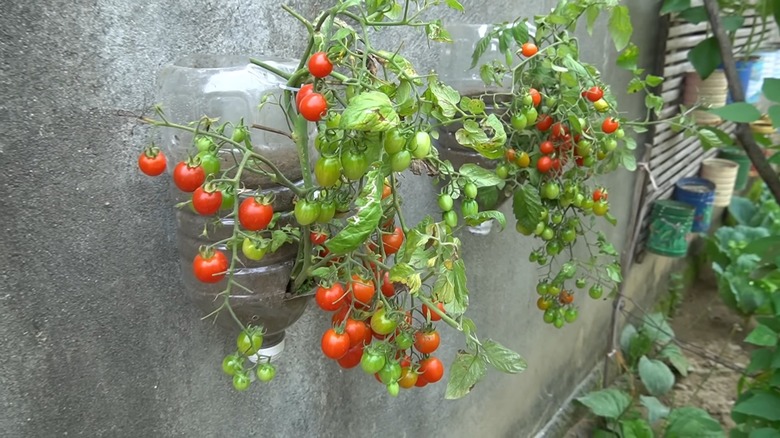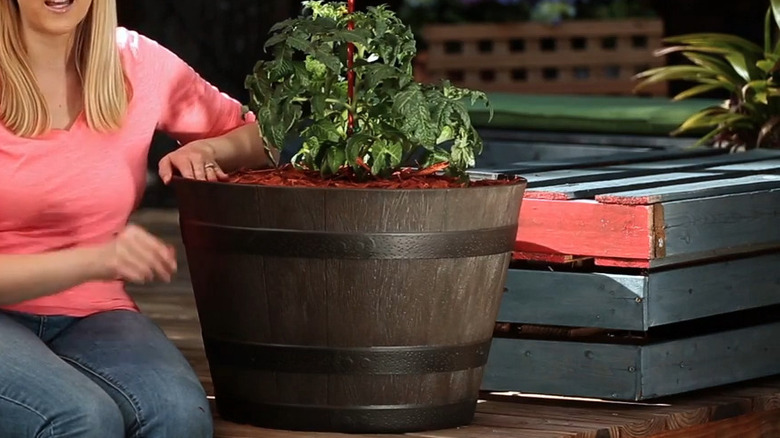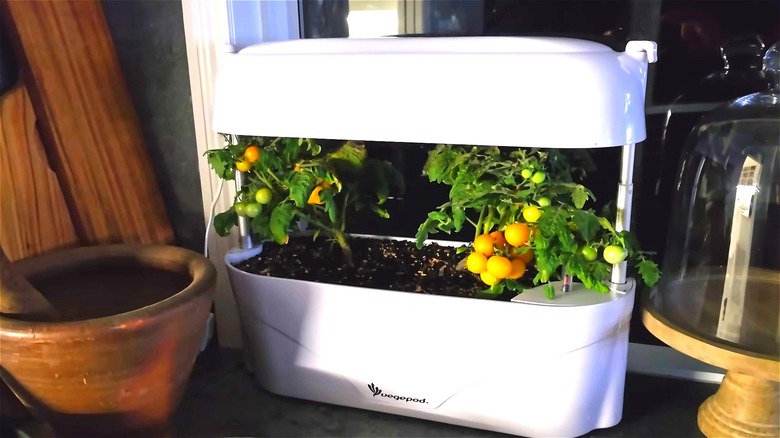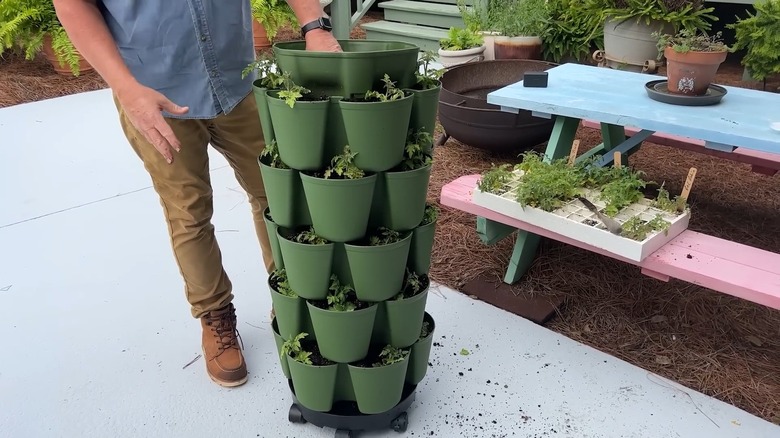17 Ways To Grow Delicious Tomatoes Without A Backyard
We may receive a commission on purchases made from links.
Does your backyard have rocks for soil, or do you live in an apartment with only a tiny balcony for outdoor space? If you don't have a suitable yard for growing produce, don't let this cease your quest for juicy, home-grown tomatoes. Sure, you're unlikely to see the gorgeous sight of big cherry red tomatoes arching over trellises in a sprawling garden within your space's confines — but a bit of creativity and know-how can nonetheless yield a mouthwatering crop right on your windowsill or patio. From pots, buckets, hanging baskets, plastic bottles, and grow bags to the more complicated and expertise-driven hydroponics, there are plenty of ways to grow delectable tomatoes without the need for a backyard.
However, there are a few limitations you must keep in mind. Not all tomato varieties translate easily to limited spaces. To elaborate, tomatoes are mostly classified as either indeterminate and determinate, with the former tending to grow indefinitely until frost, necessitating copious space. This is a huge ask for containers and baskets, thus limiting most homeowners to the more compact and bushy determinate varieties. Also, you may want to stick to proven varieties ending in "VFN," as they're more disease- and pest-hardy. Moreover, tomato roots verge on growing wider than deep, so choose your variety and its container accordingly — the golden rule is "the bigger, the better." Finally, ensure your crop receives over six hours of direct sun exposure and grows in well-draining substrates (ideally soilless potting mixes).
Grow tomatoes upside down
When space and sunshine are limited, you should explore how to grow tomato plants upside down. With this growing method, ground fungus and cutworms won't pose any nuisance, either. While commercial topsy-turvy planters are certainly available, you can also DIY your own by fixing up a 5-gallon bucket for adequate drainage. However, steer clear of breathable plastic containers, as they'll hasten evaporation, keeping the plants underwatered. Also limit yourself to small varieties like cherry tomatoes and ensure the hanging hardware is sufficiently robust to support the 50-pound mature planter suspended over your balcony. Screen for wind damage as well.
Stick tomato plants in buckets
Growing tomatoes is marvelously easy in buckets, provided they have optimum drainage holes and you've got the right tomato variety. Determinate tomatoes (quick-harvesting, short plants) can be stuck in 5-gallon buckets, but their indeterminate counterparts (longer vines) will require bigger buckets with drainage holes pierced on the sides about ½ inch above the base to build a mini water reservoir. Load the bucket with soilless mixes or compost to keep it light and relatively disease-free. Lime applications may be necessary to ensure the tomatoes receive sufficient calcium and to keep blossom end rot disease at bay.
Plant tomatoes in grow bags
If you're a patio gardener, face mobility issues, or simply despise carrying heavy clay pots, you should consider using grow bags for tomatoes. Not only are these bags reusable (can last four seasons or more) and mobile, but they also come in various sizes that can fit whichever tomato variety you choose to plant, although determinate varieties work the best. Bear in mind though that you'll have to water and fertilize the tomato plants more frequently, especially in the summer, due to leaching. Favor hard-wearing landscape or polypropylene fabric for better performance.
Pop tomatoes in black pots
If you've recently up-potted a nursery plant or are someone who wants everything in black even when growing green, you can use dark plastic pots to grow tomatoes. However, be prepared to insulate the pots, lest the accumulated heat fries the roots. Or, surround the tomatoes with other potted plants to create some shade. Also consider placing the pots over a water tray so that the soil can be moistened from below; if not, deep irrigation from the top works. If you expect the variety to grow too tall, use a tomato cage or a post for support.
Dangle tomatoes from hanging baskets
Wooden or wire baskets look nice and pretty when hovering down from rafters, walls, or a balcony. But if they're decked up in red courtesy of determinate trailing tomato vines or cherry tomatoes, that's even better. You could choose a variety like 'Tumbling Tom' or 'Tumbler'. For a delectable tomato crop, ensure you carpet the hanging basket with a liner so that the soil doesn't leach out. This will also help keep it moist for longer despite the higher exposure to sun and wind. A typical 14-inch wide hanging basket can ordinarily hold two to three plants.
Train tomato vines over a trellis
If you're really hung over a specific indeterminate tomato variety and expect it to grow over 6 feet tall, you might want to explore obelisk trellises like LeJoy Garden's 6.3 feet metal plant support that retails on Amazon for under $25 or Plow & Hearth's 5 feet powder-coated steel variant that costs around $100. Simply bury them in your selected pots or containers and guide the tomato vines along as they mature. You can maximize your harvest by planting multiple tomato plants outside the trellis' sides, provided they're spaced out according to their mature size (usually 12 inches).
Plonk tomatoes in containers
Compact tomato cultivars, such as 'Bush Early Girl' or 'Patio Choice Yellow', can be successfully grown in 14- to 20-inch decorative containers as long as they offer suitable drainage and are placed in a sunlit location well after the last frost. Other tips to grow tomatoes in containers include either treating them to a slow-release, balanced fertilizer during the growth season or irrigating them with liquid fertilizer weekly. You'll also need to raise the watering frequency to daily come summer, especially in smaller containers, to make up for the evaporative loss. Untreated redwood or red cedar pots work well, too.
Put a ring on tomatoes
Frequent traveling or tardy caregiving — if either of these brackets applies to you, growing tomatoes via ring culture may be your best option. As a bonus, it'll minimize the risk of root disease and pest pressure. On a lined deep gravel tray (or a pierced-through grow bag), place a bottomless pot (DIY one by removing any container's base) or use a readymade tomato halo (a three-pack is available from Gardener's Supply Company for $30), fill it up with compost, and place the young tomato plant inside. Keep the gravel aggregate or the outer ring of the halo watered to encourage deeper roots.
Tinker with small-scale hydroponics
Go completely soilless (and nix weeds and pests) by growing tomatoes via hydroponics. That way you can ensure a ready supply of tomatoes irrespective of the season (winter who?) while clamping down on your water use, since these systems are relatively less intensive. While premade systems such as "deep water culture" are readily available, those who are more DIY savvy can make their own versions with a food-grade plastic bin or bucket — take the tomato plant's mature canopy as a cue for size. You'll need artificial LED lighting to use indoors for a healthy crop.
Start tomato seeds in jugs
If you're up for growing tomatoes from seed, consider repurposing empty water or milk jugs to grow tomatoes. Naturally, you must rinse the jug and add drainage holes to make it into a decent greenhouse. Slicing the bottle 4 inches short of the base improves access, as you can then easily spread the potting mix and seeds and just tape the cut parts back together before moving the jug outdoors into the winter sun. Once the plants have grown and the weather is warmer, remove the top part of the jug or repot the seedlings in larger containers.
Plant tomatoes directly in planting mix bags
Another simple way to grow tomato plants, especially if you're budget is limited and you don't have pots, is to plant them straight into all-purpose planting mix bags. Get the freshest bags for superior performance and toss the soil around to decompress the soil. Poke a few 1½-inch wide holes underneath for drainage. Scissor out the middle top section in an "X" so that you can fold the material temporarily for de-clumping the soil with your hands and rooting your tomato seedling without leaving a permanent patch that constantly loses water. Alternatively, cut a square into the top of the bag.
Go mobile with rolling planters
When the sun doesn't play nice and forces you to constantly move your containers throughout the day to provide your tomatoes with all the exposure they need, you may want to consider investing in rolling planters. You could go all hi-fi with Vego Garden's much-hyped, self-watering, trellis-attached rolling planter for about $100 that makes upkeep a breeze. Or, walk down the DIY aisle by grabbing a set of two wheeled caddies from Amazon for about $24 and plop your containers or buckets on top. Alternatively, you can also give your pots a leg-up by hosting them in a wheelbarrow or a retired bicycle basket.
Put window boxes to use
Although it's well established that tomatoes need lots of room to produce their succulent fruits, certain micro and dwarf varieties such as the 'Window Box Red' micro cherry tomato or the 'Window Box Roma' can adjust inside a window box when you're out of other options. Per usual, ensure the box is big enough to accommodate their full size and that it receives adequate sunlight and water. Also be aware that your windows may eventually get shaded out by the mature plants, especially if left unpruned. Pesky bugs may also intrude your home if you aren't too careful.
Upcycle plastic bottles into tomato planters
Wish to deck your sunny wall in cascading tomato vines? Bring out your spare plastic bottles and get working. While smaller bottles are only ever good for starting tomato seedlings (as you would with milk jugs) which must be potted up eventually, bigger bottles (around 5 gallons) can be sliced in the middle to make space for a juvenile tomato variety and be affixed to the wall. Make sure to puncture a few holes for drainage and airflow and care for the plant as you would for any other container-grown tomato.
Create a tomato garden in a whiskey barrel
When Craigslist, thrift stores, or the nearest garden center throw a steal deal on half whiskey barrels at you, you ought to snag it and grow tomatoes. Sure, putting drainage holes into these heavy drums will be bothersome and the wood will eventually rot with time. But these barrels provide ample room for the vines to grow, including the indeterminate types, assuring a bountiful harvest — don't dither on stake and twine support, though. As is usual with container gardening, your plants will require daily watering and weekly fertilizer feedings.
Make use of raised garden bed kits
Raised garden beds are brilliant for growing tomatoes, and gardening companies clearly know that. The result? Raised garden bed kits that can be placed on your balcony, kitchen countertop, or any discreet corner of your home. Most kits have their own grow lights and cover, so you're pretty sorted on the sunlight end. They're also primed to contain water reservoirs so you can slip out for a mini-vacation guilt-free. The downside? You can only grow micro varieties, such as 'Tiny Tim' and 'Little Napoli F1', and they're expensive. If you're interested, check out Vegepod's options.
Stack up a generous tomato crop
Chances are you've seen some vertical planters like Greenstalk's classically gorgeous, $150, five-tier planter on social media. You may have also seen a DIY gardener's attempt at mounding Dollar Tree's 6-inch stackable planters that each cost $1.25. While these options are mostly made for growing herbs and leafy vegetables, they can also be used for compact tomato varieties (think of the Birdie series like 'Yellow Canary', 'Red Robin', and 'Rosy Finch'). However, you'll want to fill the lower stacks with stones or pin them to a fence if your area is especially windy.
